Commercial Project Negotiation: Methods, Analysis, and Strategies
VerifiedAdded on 2020/05/11
|9
|2561
|98
Report
AI Summary
This report provides a detailed analysis of commercial project negotiation, covering diverse aspects such as government and non-government project contractual arrangements, project management tools, and conflict resolution strategies. It explores the importance of negotiation in commercial projects, suggesting methods to avoid and resolve conflicts, and examining the consequences of project activity changes. The report delves into common arguments, persuasion, and influence factors among stakeholders, differentiating methods of project negotiation, conflict management, and stakeholder engagement across projects. It also explains methods for identifying and reconciling conflicting objectives, managing stakeholder relationships, and addressing project disruptions and changes, including claims for variations and damages. The report emphasizes the significance of effective communication, stakeholder engagement, and the use of project management tools to ensure successful project outcomes. It concludes that commercial projects are prone to risks and conflicts, highlighting the importance of a cautious and strategic approach for project managers to meet stakeholder expectations and ensure project success.
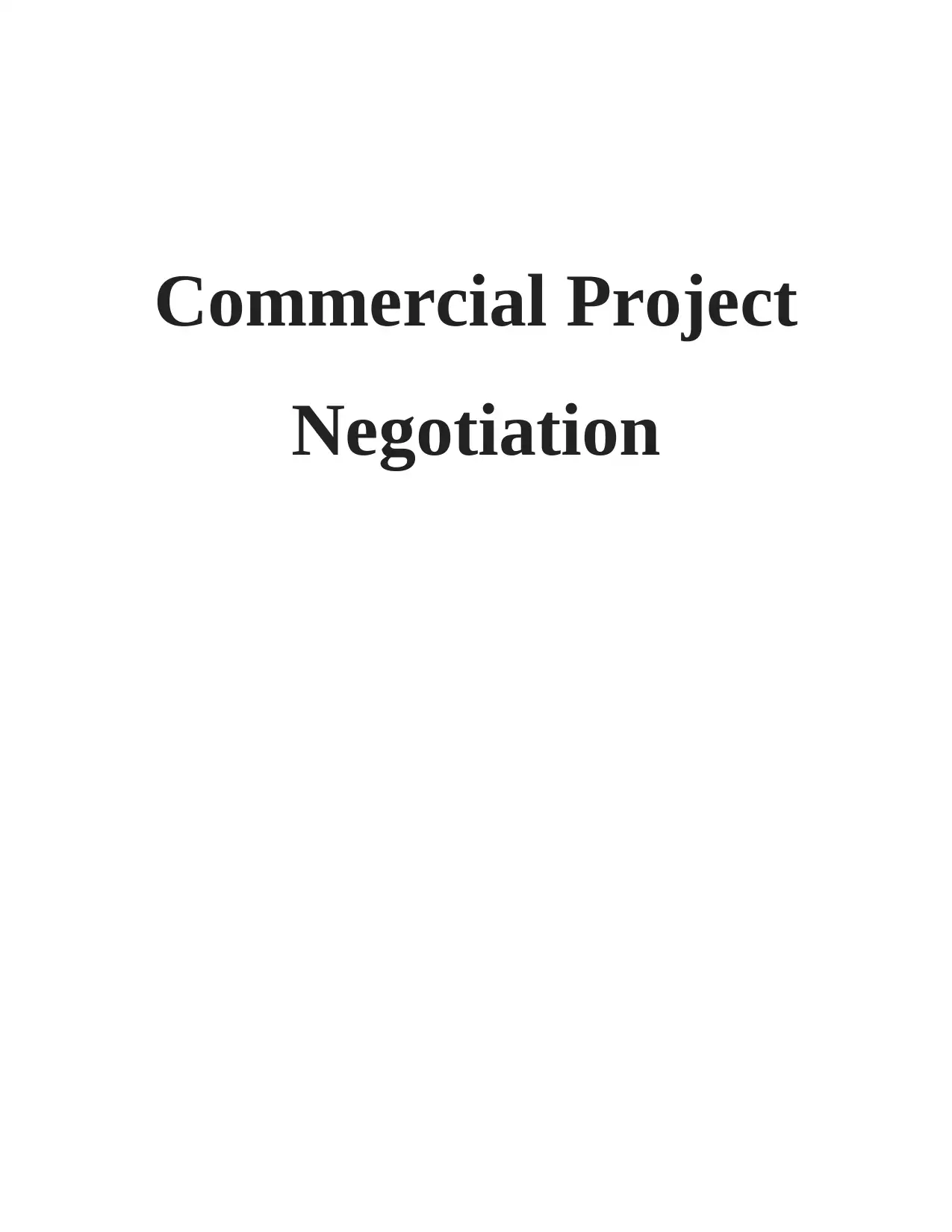
Commercial Project
Negotiation
Negotiation
Paraphrase This Document
Need a fresh take? Get an instant paraphrase of this document with our AI Paraphraser
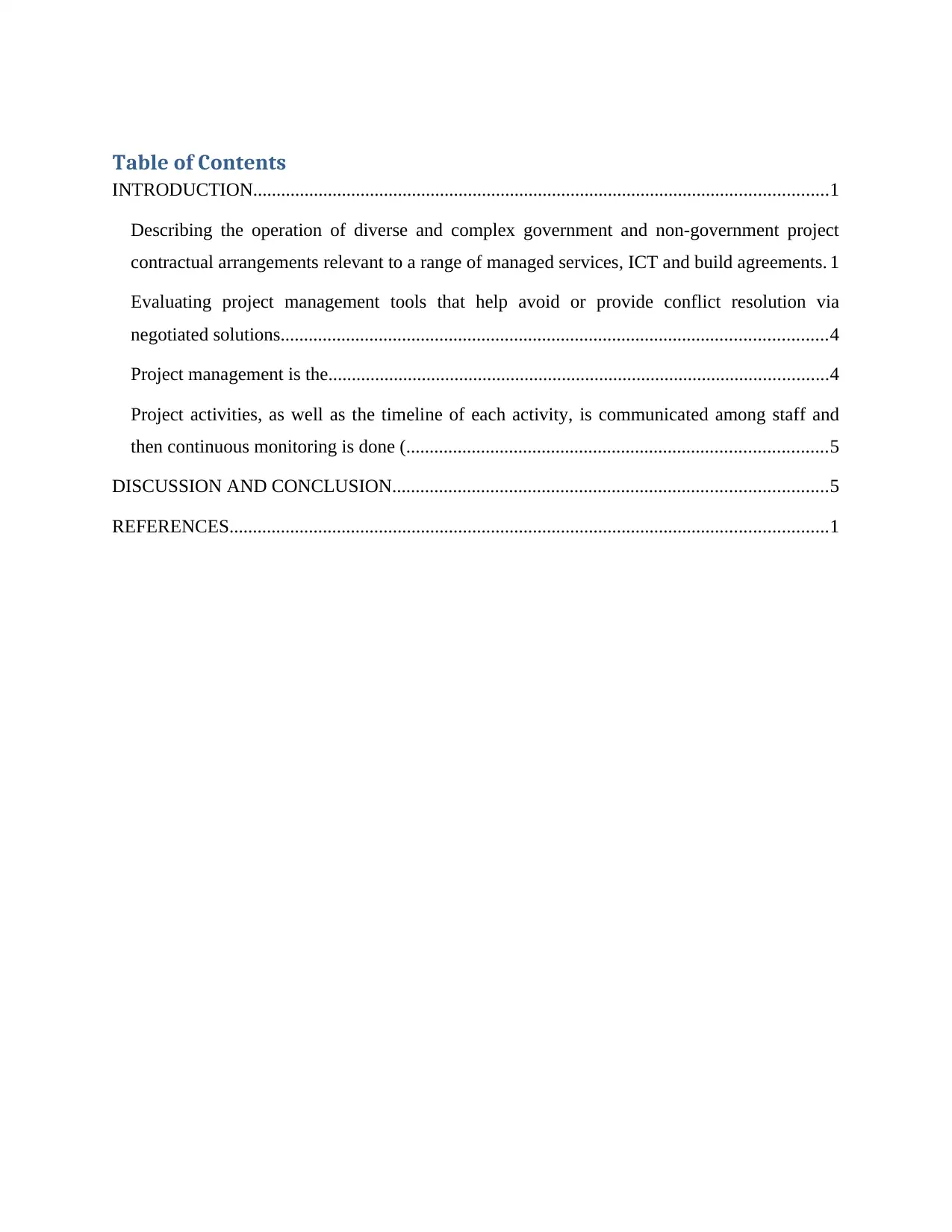
Table of Contents
INTRODUCTION...........................................................................................................................1
Describing the operation of diverse and complex government and non-government project
contractual arrangements relevant to a range of managed services, ICT and build agreements. 1
Evaluating project management tools that help avoid or provide conflict resolution via
negotiated solutions.....................................................................................................................4
Project management is the...........................................................................................................4
Project activities, as well as the timeline of each activity, is communicated among staff and
then continuous monitoring is done (..........................................................................................5
DISCUSSION AND CONCLUSION.............................................................................................5
REFERENCES................................................................................................................................1
INTRODUCTION...........................................................................................................................1
Describing the operation of diverse and complex government and non-government project
contractual arrangements relevant to a range of managed services, ICT and build agreements. 1
Evaluating project management tools that help avoid or provide conflict resolution via
negotiated solutions.....................................................................................................................4
Project management is the...........................................................................................................4
Project activities, as well as the timeline of each activity, is communicated among staff and
then continuous monitoring is done (..........................................................................................5
DISCUSSION AND CONCLUSION.............................................................................................5
REFERENCES................................................................................................................................1
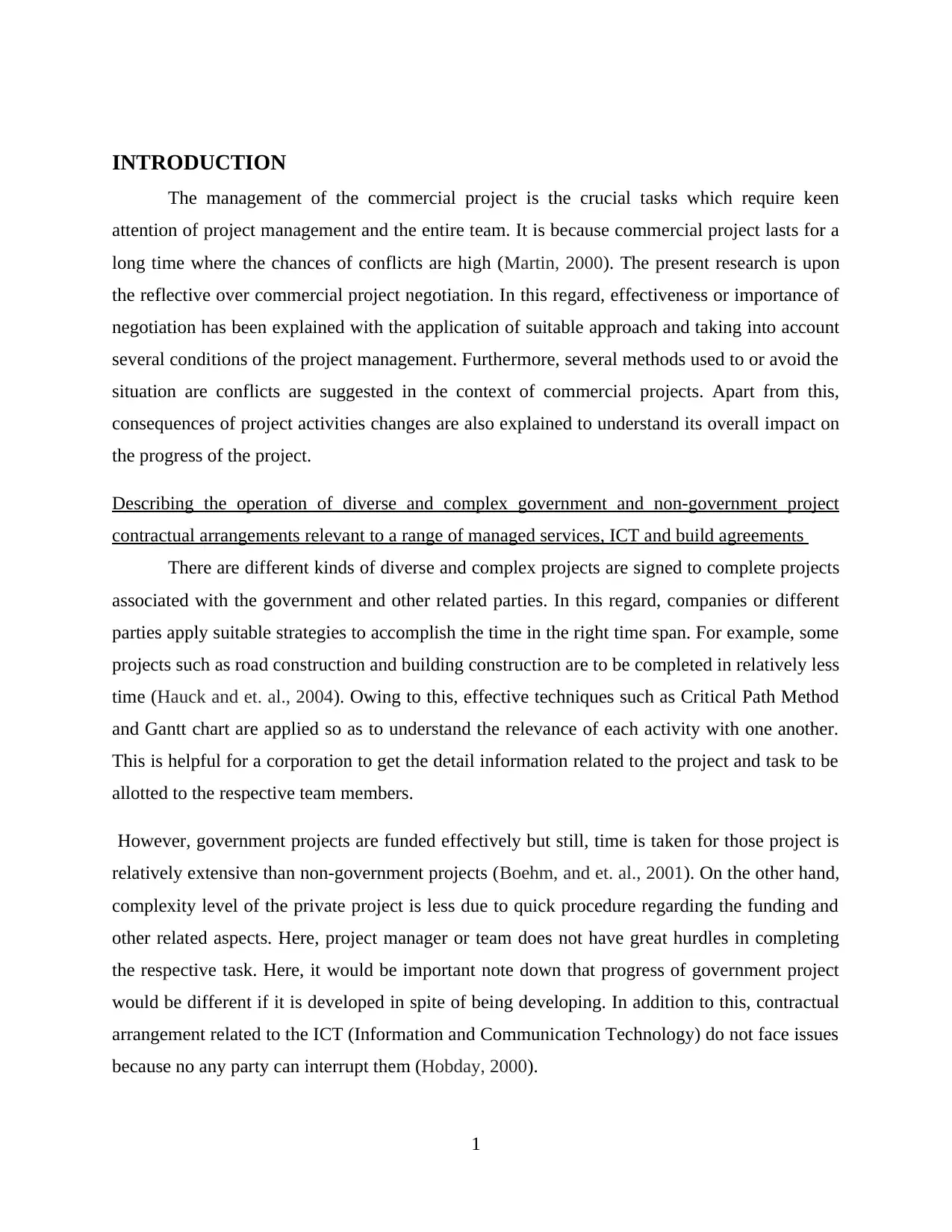
INTRODUCTION
The management of the commercial project is the crucial tasks which require keen
attention of project management and the entire team. It is because commercial project lasts for a
long time where the chances of conflicts are high (Martin, 2000). The present research is upon
the reflective over commercial project negotiation. In this regard, effectiveness or importance of
negotiation has been explained with the application of suitable approach and taking into account
several conditions of the project management. Furthermore, several methods used to or avoid the
situation are conflicts are suggested in the context of commercial projects. Apart from this,
consequences of project activities changes are also explained to understand its overall impact on
the progress of the project.
Describing the operation of diverse and complex government and non-government project
contractual arrangements relevant to a range of managed services, ICT and build agreements
There are different kinds of diverse and complex projects are signed to complete projects
associated with the government and other related parties. In this regard, companies or different
parties apply suitable strategies to accomplish the time in the right time span. For example, some
projects such as road construction and building construction are to be completed in relatively less
time (Hauck and et. al., 2004). Owing to this, effective techniques such as Critical Path Method
and Gantt chart are applied so as to understand the relevance of each activity with one another.
This is helpful for a corporation to get the detail information related to the project and task to be
allotted to the respective team members.
However, government projects are funded effectively but still, time is taken for those project is
relatively extensive than non-government projects (Boehm, and et. al., 2001). On the other hand,
complexity level of the private project is less due to quick procedure regarding the funding and
other related aspects. Here, project manager or team does not have great hurdles in completing
the respective task. Here, it would be important note down that progress of government project
would be different if it is developed in spite of being developing. In addition to this, contractual
arrangement related to the ICT (Information and Communication Technology) do not face issues
because no any party can interrupt them (Hobday, 2000).
1
The management of the commercial project is the crucial tasks which require keen
attention of project management and the entire team. It is because commercial project lasts for a
long time where the chances of conflicts are high (Martin, 2000). The present research is upon
the reflective over commercial project negotiation. In this regard, effectiveness or importance of
negotiation has been explained with the application of suitable approach and taking into account
several conditions of the project management. Furthermore, several methods used to or avoid the
situation are conflicts are suggested in the context of commercial projects. Apart from this,
consequences of project activities changes are also explained to understand its overall impact on
the progress of the project.
Describing the operation of diverse and complex government and non-government project
contractual arrangements relevant to a range of managed services, ICT and build agreements
There are different kinds of diverse and complex projects are signed to complete projects
associated with the government and other related parties. In this regard, companies or different
parties apply suitable strategies to accomplish the time in the right time span. For example, some
projects such as road construction and building construction are to be completed in relatively less
time (Hauck and et. al., 2004). Owing to this, effective techniques such as Critical Path Method
and Gantt chart are applied so as to understand the relevance of each activity with one another.
This is helpful for a corporation to get the detail information related to the project and task to be
allotted to the respective team members.
However, government projects are funded effectively but still, time is taken for those project is
relatively extensive than non-government projects (Boehm, and et. al., 2001). On the other hand,
complexity level of the private project is less due to quick procedure regarding the funding and
other related aspects. Here, project manager or team does not have great hurdles in completing
the respective task. Here, it would be important note down that progress of government project
would be different if it is developed in spite of being developing. In addition to this, contractual
arrangement related to the ICT (Information and Communication Technology) do not face issues
because no any party can interrupt them (Hobday, 2000).
1
⊘ This is a preview!⊘
Do you want full access?
Subscribe today to unlock all pages.

Trusted by 1+ million students worldwide
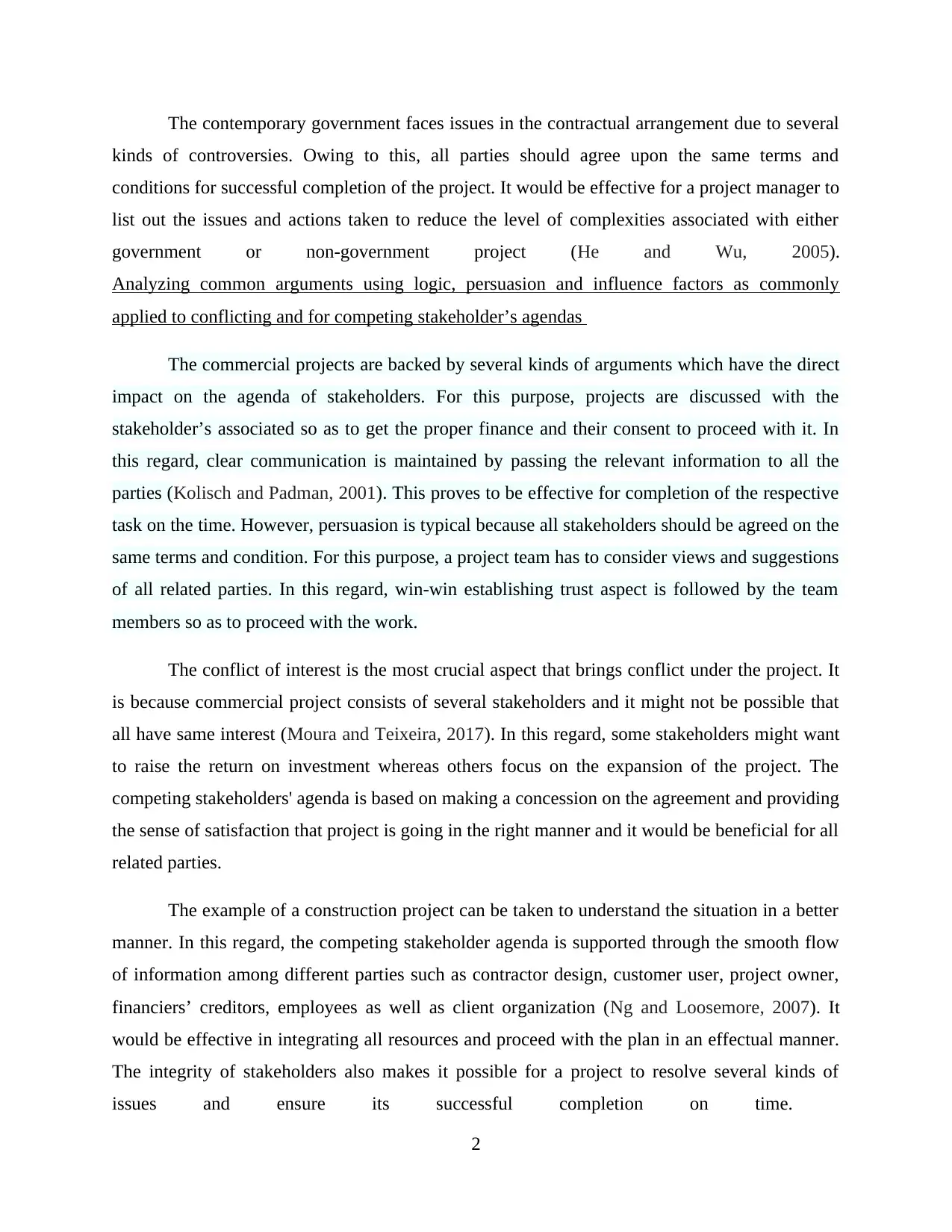
The contemporary government faces issues in the contractual arrangement due to several
kinds of controversies. Owing to this, all parties should agree upon the same terms and
conditions for successful completion of the project. It would be effective for a project manager to
list out the issues and actions taken to reduce the level of complexities associated with either
government or non-government project (He and Wu, 2005).
Analyzing common arguments using logic, persuasion and influence factors as commonly
applied to conflicting and for competing stakeholder’s agendas
The commercial projects are backed by several kinds of arguments which have the direct
impact on the agenda of stakeholders. For this purpose, projects are discussed with the
stakeholder’s associated so as to get the proper finance and their consent to proceed with it. In
this regard, clear communication is maintained by passing the relevant information to all the
parties (Kolisch and Padman, 2001). This proves to be effective for completion of the respective
task on the time. However, persuasion is typical because all stakeholders should be agreed on the
same terms and condition. For this purpose, a project team has to consider views and suggestions
of all related parties. In this regard, win-win establishing trust aspect is followed by the team
members so as to proceed with the work.
The conflict of interest is the most crucial aspect that brings conflict under the project. It
is because commercial project consists of several stakeholders and it might not be possible that
all have same interest (Moura and Teixeira, 2017). In this regard, some stakeholders might want
to raise the return on investment whereas others focus on the expansion of the project. The
competing stakeholders' agenda is based on making a concession on the agreement and providing
the sense of satisfaction that project is going in the right manner and it would be beneficial for all
related parties.
The example of a construction project can be taken to understand the situation in a better
manner. In this regard, the competing stakeholder agenda is supported through the smooth flow
of information among different parties such as contractor design, customer user, project owner,
financiers’ creditors, employees as well as client organization (Ng and Loosemore, 2007). It
would be effective in integrating all resources and proceed with the plan in an effectual manner.
The integrity of stakeholders also makes it possible for a project to resolve several kinds of
issues and ensure its successful completion on time.
2
kinds of controversies. Owing to this, all parties should agree upon the same terms and
conditions for successful completion of the project. It would be effective for a project manager to
list out the issues and actions taken to reduce the level of complexities associated with either
government or non-government project (He and Wu, 2005).
Analyzing common arguments using logic, persuasion and influence factors as commonly
applied to conflicting and for competing stakeholder’s agendas
The commercial projects are backed by several kinds of arguments which have the direct
impact on the agenda of stakeholders. For this purpose, projects are discussed with the
stakeholder’s associated so as to get the proper finance and their consent to proceed with it. In
this regard, clear communication is maintained by passing the relevant information to all the
parties (Kolisch and Padman, 2001). This proves to be effective for completion of the respective
task on the time. However, persuasion is typical because all stakeholders should be agreed on the
same terms and condition. For this purpose, a project team has to consider views and suggestions
of all related parties. In this regard, win-win establishing trust aspect is followed by the team
members so as to proceed with the work.
The conflict of interest is the most crucial aspect that brings conflict under the project. It
is because commercial project consists of several stakeholders and it might not be possible that
all have same interest (Moura and Teixeira, 2017). In this regard, some stakeholders might want
to raise the return on investment whereas others focus on the expansion of the project. The
competing stakeholders' agenda is based on making a concession on the agreement and providing
the sense of satisfaction that project is going in the right manner and it would be beneficial for all
related parties.
The example of a construction project can be taken to understand the situation in a better
manner. In this regard, the competing stakeholder agenda is supported through the smooth flow
of information among different parties such as contractor design, customer user, project owner,
financiers’ creditors, employees as well as client organization (Ng and Loosemore, 2007). It
would be effective in integrating all resources and proceed with the plan in an effectual manner.
The integrity of stakeholders also makes it possible for a project to resolve several kinds of
issues and ensure its successful completion on time.
2
Paraphrase This Document
Need a fresh take? Get an instant paraphrase of this document with our AI Paraphraser
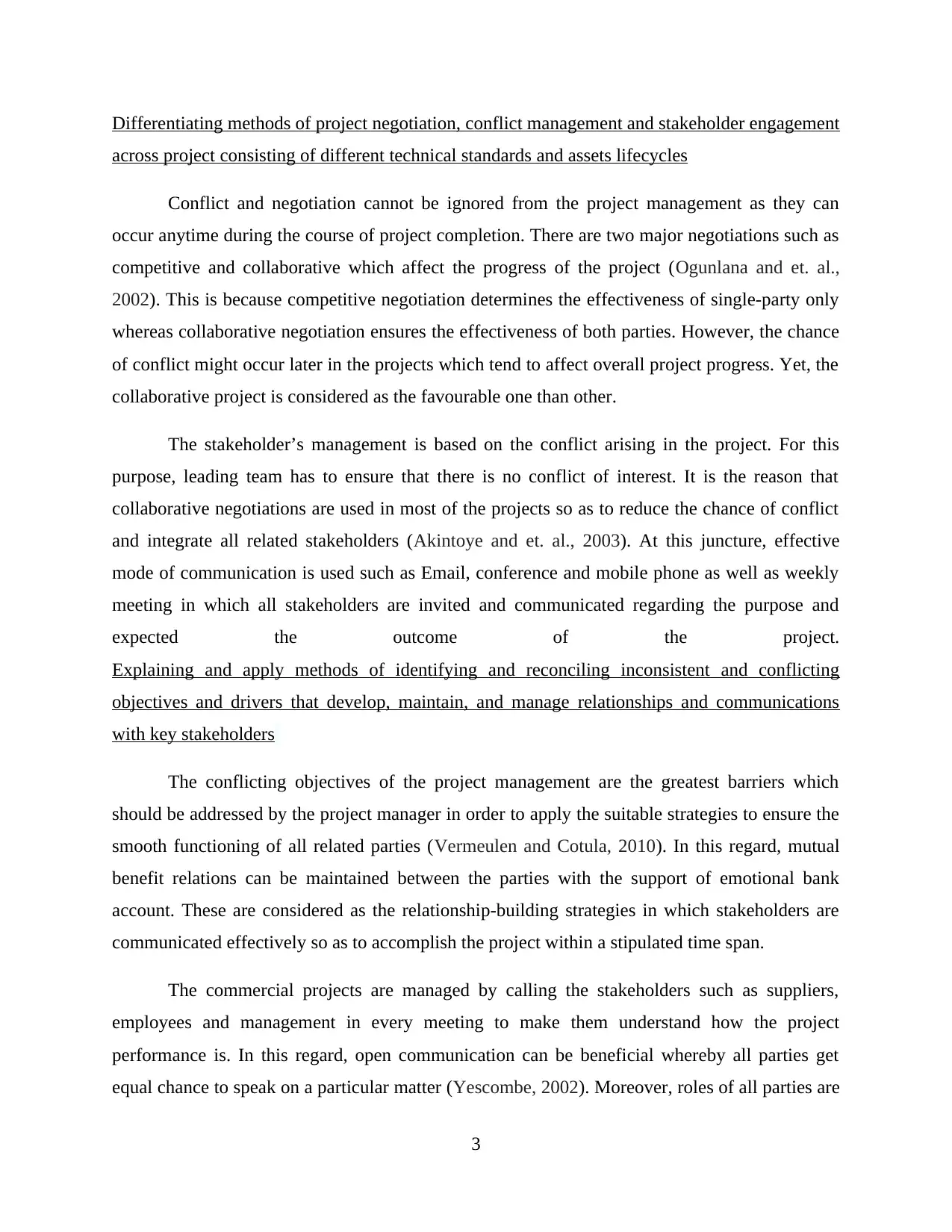
Differentiating methods of project negotiation, conflict management and stakeholder engagement
across project consisting of different technical standards and assets lifecycles
Conflict and negotiation cannot be ignored from the project management as they can
occur anytime during the course of project completion. There are two major negotiations such as
competitive and collaborative which affect the progress of the project (Ogunlana and et. al.,
2002). This is because competitive negotiation determines the effectiveness of single-party only
whereas collaborative negotiation ensures the effectiveness of both parties. However, the chance
of conflict might occur later in the projects which tend to affect overall project progress. Yet, the
collaborative project is considered as the favourable one than other.
The stakeholder’s management is based on the conflict arising in the project. For this
purpose, leading team has to ensure that there is no conflict of interest. It is the reason that
collaborative negotiations are used in most of the projects so as to reduce the chance of conflict
and integrate all related stakeholders (Akintoye and et. al., 2003). At this juncture, effective
mode of communication is used such as Email, conference and mobile phone as well as weekly
meeting in which all stakeholders are invited and communicated regarding the purpose and
expected the outcome of the project.
Explaining and apply methods of identifying and reconciling inconsistent and conflicting
objectives and drivers that develop, maintain, and manage relationships and communications
with key stakeholders
The conflicting objectives of the project management are the greatest barriers which
should be addressed by the project manager in order to apply the suitable strategies to ensure the
smooth functioning of all related parties (Vermeulen and Cotula, 2010). In this regard, mutual
benefit relations can be maintained between the parties with the support of emotional bank
account. These are considered as the relationship-building strategies in which stakeholders are
communicated effectively so as to accomplish the project within a stipulated time span.
The commercial projects are managed by calling the stakeholders such as suppliers,
employees and management in every meeting to make them understand how the project
performance is. In this regard, open communication can be beneficial whereby all parties get
equal chance to speak on a particular matter (Yescombe, 2002). Moreover, roles of all parties are
3
across project consisting of different technical standards and assets lifecycles
Conflict and negotiation cannot be ignored from the project management as they can
occur anytime during the course of project completion. There are two major negotiations such as
competitive and collaborative which affect the progress of the project (Ogunlana and et. al.,
2002). This is because competitive negotiation determines the effectiveness of single-party only
whereas collaborative negotiation ensures the effectiveness of both parties. However, the chance
of conflict might occur later in the projects which tend to affect overall project progress. Yet, the
collaborative project is considered as the favourable one than other.
The stakeholder’s management is based on the conflict arising in the project. For this
purpose, leading team has to ensure that there is no conflict of interest. It is the reason that
collaborative negotiations are used in most of the projects so as to reduce the chance of conflict
and integrate all related stakeholders (Akintoye and et. al., 2003). At this juncture, effective
mode of communication is used such as Email, conference and mobile phone as well as weekly
meeting in which all stakeholders are invited and communicated regarding the purpose and
expected the outcome of the project.
Explaining and apply methods of identifying and reconciling inconsistent and conflicting
objectives and drivers that develop, maintain, and manage relationships and communications
with key stakeholders
The conflicting objectives of the project management are the greatest barriers which
should be addressed by the project manager in order to apply the suitable strategies to ensure the
smooth functioning of all related parties (Vermeulen and Cotula, 2010). In this regard, mutual
benefit relations can be maintained between the parties with the support of emotional bank
account. These are considered as the relationship-building strategies in which stakeholders are
communicated effectively so as to accomplish the project within a stipulated time span.
The commercial projects are managed by calling the stakeholders such as suppliers,
employees and management in every meeting to make them understand how the project
performance is. In this regard, open communication can be beneficial whereby all parties get
equal chance to speak on a particular matter (Yescombe, 2002). Moreover, roles of all parties are
3
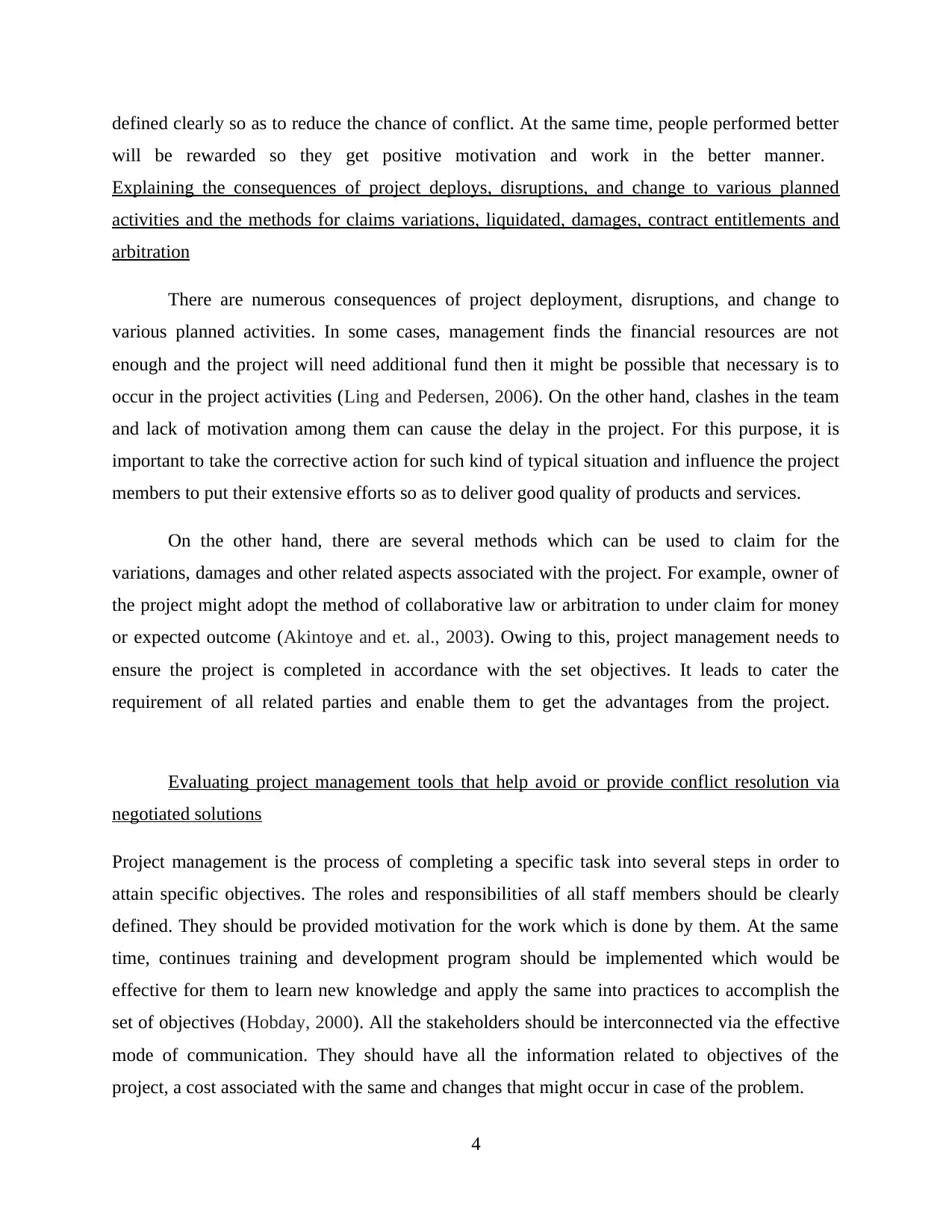
defined clearly so as to reduce the chance of conflict. At the same time, people performed better
will be rewarded so they get positive motivation and work in the better manner.
Explaining the consequences of project deploys, disruptions, and change to various planned
activities and the methods for claims variations, liquidated, damages, contract entitlements and
arbitration
There are numerous consequences of project deployment, disruptions, and change to
various planned activities. In some cases, management finds the financial resources are not
enough and the project will need additional fund then it might be possible that necessary is to
occur in the project activities (Ling and Pedersen, 2006). On the other hand, clashes in the team
and lack of motivation among them can cause the delay in the project. For this purpose, it is
important to take the corrective action for such kind of typical situation and influence the project
members to put their extensive efforts so as to deliver good quality of products and services.
On the other hand, there are several methods which can be used to claim for the
variations, damages and other related aspects associated with the project. For example, owner of
the project might adopt the method of collaborative law or arbitration to under claim for money
or expected outcome (Akintoye and et. al., 2003). Owing to this, project management needs to
ensure the project is completed in accordance with the set objectives. It leads to cater the
requirement of all related parties and enable them to get the advantages from the project.
Evaluating project management tools that help avoid or provide conflict resolution via
negotiated solutions
Project management is the process of completing a specific task into several steps in order to
attain specific objectives. The roles and responsibilities of all staff members should be clearly
defined. They should be provided motivation for the work which is done by them. At the same
time, continues training and development program should be implemented which would be
effective for them to learn new knowledge and apply the same into practices to accomplish the
set of objectives (Hobday, 2000). All the stakeholders should be interconnected via the effective
mode of communication. They should have all the information related to objectives of the
project, a cost associated with the same and changes that might occur in case of the problem.
4
will be rewarded so they get positive motivation and work in the better manner.
Explaining the consequences of project deploys, disruptions, and change to various planned
activities and the methods for claims variations, liquidated, damages, contract entitlements and
arbitration
There are numerous consequences of project deployment, disruptions, and change to
various planned activities. In some cases, management finds the financial resources are not
enough and the project will need additional fund then it might be possible that necessary is to
occur in the project activities (Ling and Pedersen, 2006). On the other hand, clashes in the team
and lack of motivation among them can cause the delay in the project. For this purpose, it is
important to take the corrective action for such kind of typical situation and influence the project
members to put their extensive efforts so as to deliver good quality of products and services.
On the other hand, there are several methods which can be used to claim for the
variations, damages and other related aspects associated with the project. For example, owner of
the project might adopt the method of collaborative law or arbitration to under claim for money
or expected outcome (Akintoye and et. al., 2003). Owing to this, project management needs to
ensure the project is completed in accordance with the set objectives. It leads to cater the
requirement of all related parties and enable them to get the advantages from the project.
Evaluating project management tools that help avoid or provide conflict resolution via
negotiated solutions
Project management is the process of completing a specific task into several steps in order to
attain specific objectives. The roles and responsibilities of all staff members should be clearly
defined. They should be provided motivation for the work which is done by them. At the same
time, continues training and development program should be implemented which would be
effective for them to learn new knowledge and apply the same into practices to accomplish the
set of objectives (Hobday, 2000). All the stakeholders should be interconnected via the effective
mode of communication. They should have all the information related to objectives of the
project, a cost associated with the same and changes that might occur in case of the problem.
4
⊘ This is a preview!⊘
Do you want full access?
Subscribe today to unlock all pages.

Trusted by 1+ million students worldwide
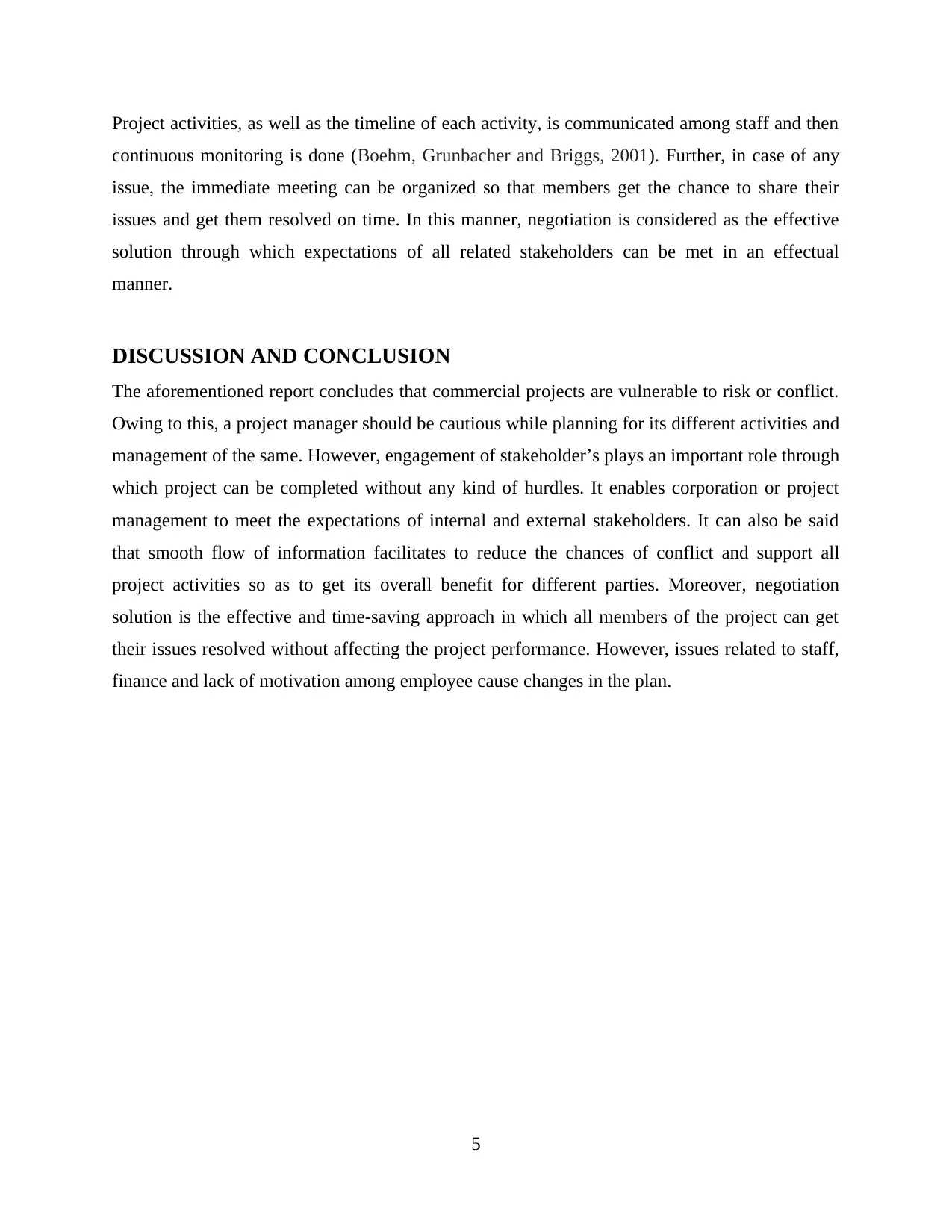
Project activities, as well as the timeline of each activity, is communicated among staff and then
continuous monitoring is done (Boehm, Grunbacher and Briggs, 2001). Further, in case of any
issue, the immediate meeting can be organized so that members get the chance to share their
issues and get them resolved on time. In this manner, negotiation is considered as the effective
solution through which expectations of all related stakeholders can be met in an effectual
manner.
DISCUSSION AND CONCLUSION
The aforementioned report concludes that commercial projects are vulnerable to risk or conflict.
Owing to this, a project manager should be cautious while planning for its different activities and
management of the same. However, engagement of stakeholder’s plays an important role through
which project can be completed without any kind of hurdles. It enables corporation or project
management to meet the expectations of internal and external stakeholders. It can also be said
that smooth flow of information facilitates to reduce the chances of conflict and support all
project activities so as to get its overall benefit for different parties. Moreover, negotiation
solution is the effective and time-saving approach in which all members of the project can get
their issues resolved without affecting the project performance. However, issues related to staff,
finance and lack of motivation among employee cause changes in the plan.
5
continuous monitoring is done (Boehm, Grunbacher and Briggs, 2001). Further, in case of any
issue, the immediate meeting can be organized so that members get the chance to share their
issues and get them resolved on time. In this manner, negotiation is considered as the effective
solution through which expectations of all related stakeholders can be met in an effectual
manner.
DISCUSSION AND CONCLUSION
The aforementioned report concludes that commercial projects are vulnerable to risk or conflict.
Owing to this, a project manager should be cautious while planning for its different activities and
management of the same. However, engagement of stakeholder’s plays an important role through
which project can be completed without any kind of hurdles. It enables corporation or project
management to meet the expectations of internal and external stakeholders. It can also be said
that smooth flow of information facilitates to reduce the chances of conflict and support all
project activities so as to get its overall benefit for different parties. Moreover, negotiation
solution is the effective and time-saving approach in which all members of the project can get
their issues resolved without affecting the project performance. However, issues related to staff,
finance and lack of motivation among employee cause changes in the plan.
5
Paraphrase This Document
Need a fresh take? Get an instant paraphrase of this document with our AI Paraphraser
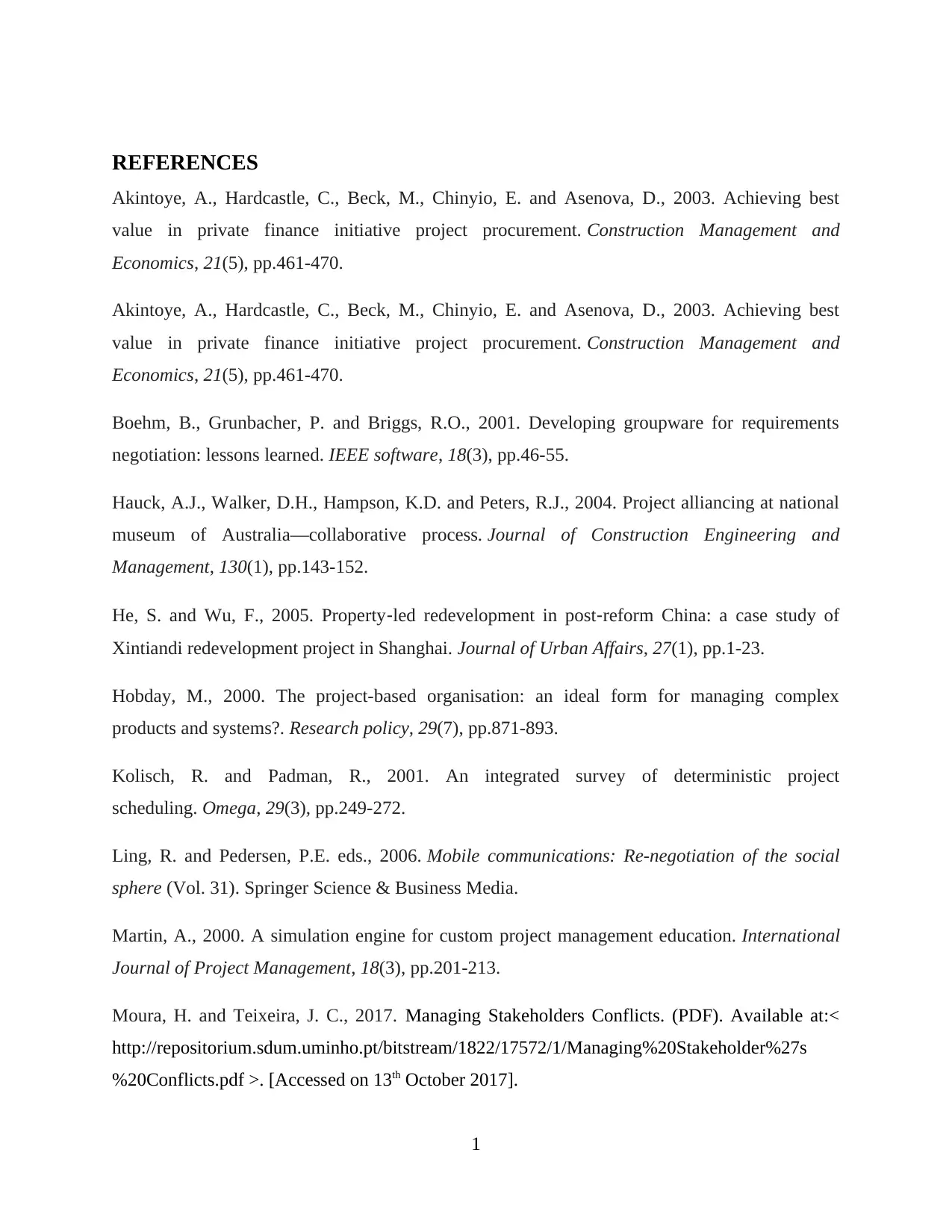
REFERENCES
Akintoye, A., Hardcastle, C., Beck, M., Chinyio, E. and Asenova, D., 2003. Achieving best
value in private finance initiative project procurement. Construction Management and
Economics, 21(5), pp.461-470.
Akintoye, A., Hardcastle, C., Beck, M., Chinyio, E. and Asenova, D., 2003. Achieving best
value in private finance initiative project procurement. Construction Management and
Economics, 21(5), pp.461-470.
Boehm, B., Grunbacher, P. and Briggs, R.O., 2001. Developing groupware for requirements
negotiation: lessons learned. IEEE software, 18(3), pp.46-55.
Hauck, A.J., Walker, D.H., Hampson, K.D. and Peters, R.J., 2004. Project alliancing at national
museum of Australia—collaborative process. Journal of Construction Engineering and
Management, 130(1), pp.143-152.
He, S. and Wu, F., 2005. Property‐led redevelopment in post‐reform China: a case study of
Xintiandi redevelopment project in Shanghai. Journal of Urban Affairs, 27(1), pp.1-23.
Hobday, M., 2000. The project-based organisation: an ideal form for managing complex
products and systems?. Research policy, 29(7), pp.871-893.
Kolisch, R. and Padman, R., 2001. An integrated survey of deterministic project
scheduling. Omega, 29(3), pp.249-272.
Ling, R. and Pedersen, P.E. eds., 2006. Mobile communications: Re-negotiation of the social
sphere (Vol. 31). Springer Science & Business Media.
Martin, A., 2000. A simulation engine for custom project management education. International
Journal of Project Management, 18(3), pp.201-213.
Moura, H. and Teixeira, J. C., 2017. Managing Stakeholders Conflicts. (PDF). Available at:<
http://repositorium.sdum.uminho.pt/bitstream/1822/17572/1/Managing%20Stakeholder%27s
%20Conflicts.pdf >. [Accessed on 13th October 2017].
1
Akintoye, A., Hardcastle, C., Beck, M., Chinyio, E. and Asenova, D., 2003. Achieving best
value in private finance initiative project procurement. Construction Management and
Economics, 21(5), pp.461-470.
Akintoye, A., Hardcastle, C., Beck, M., Chinyio, E. and Asenova, D., 2003. Achieving best
value in private finance initiative project procurement. Construction Management and
Economics, 21(5), pp.461-470.
Boehm, B., Grunbacher, P. and Briggs, R.O., 2001. Developing groupware for requirements
negotiation: lessons learned. IEEE software, 18(3), pp.46-55.
Hauck, A.J., Walker, D.H., Hampson, K.D. and Peters, R.J., 2004. Project alliancing at national
museum of Australia—collaborative process. Journal of Construction Engineering and
Management, 130(1), pp.143-152.
He, S. and Wu, F., 2005. Property‐led redevelopment in post‐reform China: a case study of
Xintiandi redevelopment project in Shanghai. Journal of Urban Affairs, 27(1), pp.1-23.
Hobday, M., 2000. The project-based organisation: an ideal form for managing complex
products and systems?. Research policy, 29(7), pp.871-893.
Kolisch, R. and Padman, R., 2001. An integrated survey of deterministic project
scheduling. Omega, 29(3), pp.249-272.
Ling, R. and Pedersen, P.E. eds., 2006. Mobile communications: Re-negotiation of the social
sphere (Vol. 31). Springer Science & Business Media.
Martin, A., 2000. A simulation engine for custom project management education. International
Journal of Project Management, 18(3), pp.201-213.
Moura, H. and Teixeira, J. C., 2017. Managing Stakeholders Conflicts. (PDF). Available at:<
http://repositorium.sdum.uminho.pt/bitstream/1822/17572/1/Managing%20Stakeholder%27s
%20Conflicts.pdf >. [Accessed on 13th October 2017].
1
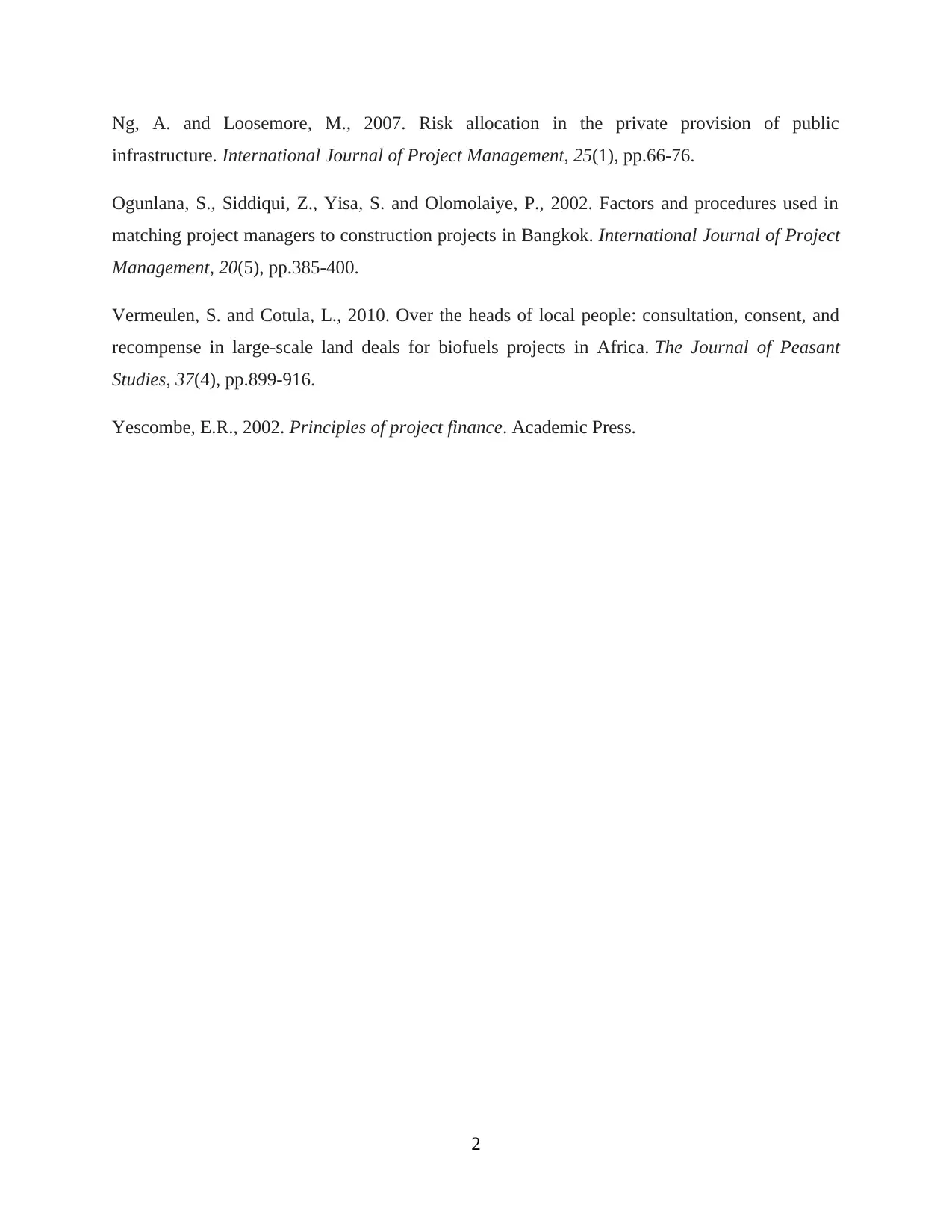
Ng, A. and Loosemore, M., 2007. Risk allocation in the private provision of public
infrastructure. International Journal of Project Management, 25(1), pp.66-76.
Ogunlana, S., Siddiqui, Z., Yisa, S. and Olomolaiye, P., 2002. Factors and procedures used in
matching project managers to construction projects in Bangkok. International Journal of Project
Management, 20(5), pp.385-400.
Vermeulen, S. and Cotula, L., 2010. Over the heads of local people: consultation, consent, and
recompense in large-scale land deals for biofuels projects in Africa. The Journal of Peasant
Studies, 37(4), pp.899-916.
Yescombe, E.R., 2002. Principles of project finance. Academic Press.
2
infrastructure. International Journal of Project Management, 25(1), pp.66-76.
Ogunlana, S., Siddiqui, Z., Yisa, S. and Olomolaiye, P., 2002. Factors and procedures used in
matching project managers to construction projects in Bangkok. International Journal of Project
Management, 20(5), pp.385-400.
Vermeulen, S. and Cotula, L., 2010. Over the heads of local people: consultation, consent, and
recompense in large-scale land deals for biofuels projects in Africa. The Journal of Peasant
Studies, 37(4), pp.899-916.
Yescombe, E.R., 2002. Principles of project finance. Academic Press.
2
⊘ This is a preview!⊘
Do you want full access?
Subscribe today to unlock all pages.

Trusted by 1+ million students worldwide
1 out of 9
Related Documents
Your All-in-One AI-Powered Toolkit for Academic Success.
+13062052269
info@desklib.com
Available 24*7 on WhatsApp / Email
![[object Object]](/_next/static/media/star-bottom.7253800d.svg)
Unlock your academic potential
Copyright © 2020–2025 A2Z Services. All Rights Reserved. Developed and managed by ZUCOL.




